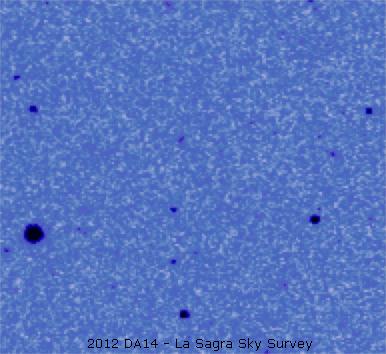A newly discovered asteroid has been predicted to slightly miss the Earth, during its entry in 2013. The space rock, measuring 50 m, will approach closer when compared to other satellites. Hence, it is essential to be aware of the potential hazards existing in space.
 Current predictions indicate that on its next flyby, due on 15 February 2013, it will pass Earth at just 24 000 km – closer than many commercial satellites. "This is a safe distance, but it is still close enough to make the asteroid visible in normal binoculars," says Detlef Koschny, responsible for near-earth objects in ESA's Space Situational Awareness (SSA) office. Credits: ESA/La Sagra Sky Survey
Current predictions indicate that on its next flyby, due on 15 February 2013, it will pass Earth at just 24 000 km – closer than many commercial satellites. "This is a safe distance, but it is still close enough to make the asteroid visible in normal binoculars," says Detlef Koschny, responsible for near-earth objects in ESA's Space Situational Awareness (SSA) office. Credits: ESA/La Sagra Sky Survey
An unusual asteroid called 2012 DA14 was discovered by an amateur team on 22 February 2012. It was however identified only after its travel across the Earth which was represented by its small size and orbit. It has been assumed to have travelled a distance of up to seven times than that of the Moon.
During its subsequent flyby, scheduled on 15 February 2013, it will pass the Earth closer than other commercial satellites, at about 24 000 km.
The Spain-based La Sagra Sky Survey observatory discovered the asteroid at an altitude of 1700 m. It is one of the minimal light-polluted and darkest locations in the mainland of Europe.
Several automated telescopes enabled the team to examine the sky. Following the idea to explore the sky-areas where asteroids are not generally viewed, the team spotted the asteroid by chance.
As the asteroids will not impact the Earth during its next visit, its close approach will enable astronomers to conduct more studies and to evaluate the gravitational effects of Earth and Moon on it.
Operated by the Observatorio Astronomico de Mallorca, the La Sagra Sky Survey has recently become a part of the SSA programme of ESA.
The SSA office has benefited by the discovery of 2012 DA14 as it characterizes the projected half a million undiscovered near-Earth objects stretching up to 30 m. Backed by European industry, the ESA team is designing a network of 1 m-diameter telescopes that can scan the entire sky in one night.
Supported by the Agency’s Space Situational Awareness Preparatory Programme, the initiative is currently under progress.